During August, we’re doing reruns of a few of the more popular Posts from years past – very slightly revised.
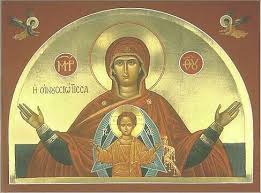
Last week we saw how often the Virgin Mary is mentioned in the New Testament. Nobody except her Son comes close. Then… well, go back and read it for yourself. We stopped in the middle this section.
What the Bible teaches about Mary
5 Does the New Testament tell us that Mary is the Mother of Christians, the Mother of the Church? Yes. There is, of course, no distinction between the titles, since the Church is the People of God.
Let’s spend some time on this one.
First, the theology. In the New Testament, the Church is the “Body of Christ”, the place of His bodily Presence in the world – as is the Holy Eucharist, but that’s another story. As Paul  put it, Christ is the Head, we are the members of his Body. 1 Corinthians 12:27 – united with Him just as hands and arms are part of the human body. Now, Christ is God. He has never been limited to the Divine Human Being who dwelt on earth – neither before His Incarnation nor after His Ascension. In His Person He now incorporates all who are joined to Him into a “multi-personal bodily Person”. (Is that a safe way of expressing the Mystery?) Anyway, the point is that, since Mary gave birth to Christ bodily and is His Mother, it follows that she is necessarily also Mother of His Body the Church. Therefore she is our Mother, too.
put it, Christ is the Head, we are the members of his Body. 1 Corinthians 12:27 – united with Him just as hands and arms are part of the human body. Now, Christ is God. He has never been limited to the Divine Human Being who dwelt on earth – neither before His Incarnation nor after His Ascension. In His Person He now incorporates all who are joined to Him into a “multi-personal bodily Person”. (Is that a safe way of expressing the Mystery?) Anyway, the point is that, since Mary gave birth to Christ bodily and is His Mother, it follows that she is necessarily also Mother of His Body the Church. Therefore she is our Mother, too.
Let’s come at it in another more “human” way, and look at a sometimes misunderstood passage.
“While Jesus was still talking to the crowd, His mother and brothers stood outside, wanting to speak to Him. Someone told Him, ‘Your mother and brothers are standing outside, wanting to speak to you.’ He replied, ‘Who is my mother, and who are my brothers?’ Pointing to His disciples, He said, ‘Here are my Mother and my brothers. For whoever does the will of my Father in Heaven is my brother and sister and mother.’” Matthew 12:46-50
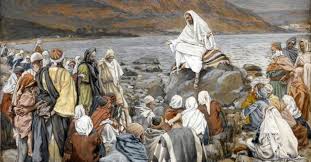
At first reading this seems to be a sort of “putdown” of His Mother. But that couldn’t have been the case. We know how He loved and respected her. For example, at the Wedding at Cana of Galilee He even allowed her to influence Him – and indeed He learned from her how to “make the most” of His first great Sign. (We’ll say more about that in a minute.) You know how from the Cross, He provided her a new “son” John, to care for her after His death. And especially in this instance when she came worrying, as all loving mothers would, to make sure her Son was looking after Himself, how could He help but love her? So He could not have been rejecting her. There must be another “angle” on this.
There is. Here Jesus was honoring His Mother, for He knew she had completely obeyed and kept the will of God. She had said to the Archangel, “Let it be to me according to your word”. Now Christ was expanding His family (and hers) from a natural family into a “super-natural” Family. People would become members of His Family, not by the water of the womb and physical birth, but by the water of Baptism and a new spiritual birth into a new life of doing the will of His Father – just as she already had.
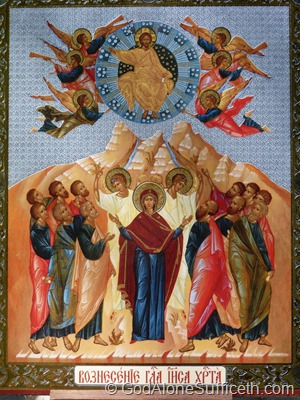 An Italian movie from the 1960s* showed the Virgin Mary realistically, now in her 40s. When she first heard these words of Jesus, she looked shocked – but then she looked out over the crowd, and very slowly a big smile came over her face. You could see what she was thinking: “Now they’re all my family!”
An Italian movie from the 1960s* showed the Virgin Mary realistically, now in her 40s. When she first heard these words of Jesus, she looked shocked – but then she looked out over the crowd, and very slowly a big smile came over her face. You could see what she was thinking: “Now they’re all my family!”
- “The Gospel according to Saint Matthew”, directed by a Communist who had come across a Gideon Bible, had read the Gospel and was fascinated. (He didn’t know what to do with a few things – like the miracles and the Resurrection!)
What would any family be without a loving mother? And Mary is the best of them. Why else would God have chosen her to be His own dear Mother? Generation after generation of Christians have turned to her for what mothers provide so well: a godly pattern to follow, help, consolation, comfort, guidance, motherly love – someone to care about us as she did for her Son. Mary, the Mother of Christ our God and Mother of all Christians, to all who follow her example: “Let it be to me according to your word.”
Does this in any way detract from our love of God? our love for Jesus? Of course not. People, get rational! Think! Does your love for your own natural mother separate you from God? Then why ever should our love for our Mother Mary do that?
6 Does the Bible teach that Mary is our Advocate with her Son? Yes. As we suggested in the last Post, at the Wedding in Cana of Galilee she “advocated” with her Son on behalf of a family friend. If she did it then, why would she have stopped now? Certainly she doesn’t talk Him into something He does not will to do, contrary to the will of His Father.
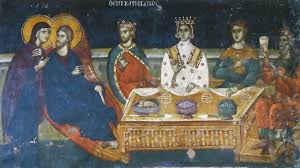
But at Cana she helped Him see what His will really was. He was hesitating. I’d guess He wanted to do something more significant for His first Sign, rather than “waste” it making wine for a wedding reception. It was our son David’s godmother who helped me understand this, just as Mary helped Jesus to understand. This was an act of pure unselfish humble kindness, done quietly without calling attention to Himself, just to save a family friend from embarrassment. That was no “waste”. It was the love, the kindness of God in action.
So why should their relationship have changed now? I’m thinking things in Heaven are not so far different from those on earth – including the relationship of Mary and her Son. I think we tend to “overspiritualize” (de-humanize?) heaven. We don’t know the “ins and outs” of that blessed Land. But we do know that Jesus Christ rose bodily and ascended bodily. He is still a human being, a Man – the Fourth Ecumenical Council made that clear. And His Mother is still His Mother. I suspect she still whispers into His ear from time to time.
7 Do the Scriptures teach that Mary has been glorified in heaven? This is something that most Protestant Christians miss. The answer is: Yes.

August 15, is the day when both Orthodox and Roman Catholics celebrate the major feast of Mary’s death and entrance into heaven. We each take a slightly different approach concerning precisely what happened then. English-speaking Orthodox usually title the day “The Dormition” * which is Latin for “Falling Asleep”. (The Greek word is “Kimissis”.) Our Orthodox icon shows Christ receiving her pure soul into heaven.
- Odd that we use a Latin term for the day.
Roman Catholics call the day “The Assumption”. They have a dogma (promulgated not until 1950, but believed much earlier) that she was taken bodily (assumed) into Heaven, like her Son. Probably most Orthodox believe this as well. * Many Orthodox sources, both popular and scholarly, seem to take her bodily Assumption for granted, but we have no formal teaching about it. After thirty years of searching (and in that time I have only seen a little of the Orthodox Church’s voluminous hymnology) thus far I have found not one official Orthodox hymn or text that clearly and directly refers to her Assumption. Both Roman Catholics and Orthodox agree that the Mother of God has now been glorified in heaven.

I believe in her Bodily Assumption, on the evidence. There are relics of all the Apostles, plus other early Saints. Where are Mary’s relics? There are none, nor has anyone ever claimed to have any. According to tradition, the Apostles were present when she died and was entombed. We know the location – in the Kedron Valley just east of Jerusalem.
A narrative known as the Euthymiacal History (written probably by Cyril of Scythopolis in the Fifth Century) relates how the Emperor Marcian requested the relics of the Virgin Mary from Juvenal, the Patriarch of Jerusalem, at the time of the Fourth Ecumenical Council (451). According to the account, Juvenal replied that, on the third day after her burial, Mary’s tomb was discovered to be empty, Only her shroud was being preserved in the church of Gethsemane.
Why do we believe she has been glorified? Because John * wrote about it: “Now a great sign appeared in heaven, a Woman clothed with the sun, with the moon under her feet and on her head a garland of twelve stars… She bore a male Child who was to rule all nations with a rod of iron”. Revelation 12
-

Cave of the Apocalypse, Patmos (courtestay of Thomas Institute) Some Biblical critics theorize that John the Apostle didn’t write this. All I can say is: Visit the island of Patmos. You’ll rethink your theory.
Some say the Woman in the vision is Judaism which gave birth to the Messiah, so to speak, with the twelve stars representing the twelve tribes. Some say she is the Church which now brings Christ into the world. I think that is true, for she is adorned by the Twelve Aposttles and she is Mother of the Church. However, Scriptural images and stories can have more than one level of interpretation.
But John, first of all, must surely have meant Mary, the Woman who literally gave birth to the One who was to rule the world? Mary, his adopted Mother, and he her adopted son – whom he looked after for the rest of her life. She must have been on his mind almost continually.
And there is this: At the beginning of his Revelation, John had seen Jesus Christ radiant in His own heavenly light. Revelation 1:9-18 Now he sees Mary clothed with the light of Her Son, Mary now “deified”. Mary with the moon, this lower world, at her feet – Mother of the world. Mary adorned by twelve stars, the Apostles – Mother of the Church. This humble girl from a little village of Galilee!
The Virgin Mary has been glorified in heaven. This surely is the meaning of this passage – and it’s startling how many non-Orthodox, non-Roman Catholic commentaries studiously avoid it!
Choir of Saint Symeon’s Church (OCA), Birmingham, Alabama
8 Has the Orthodox Church here turned Mary into a “mother goddess”, as some contend? No. But God has!
Chanted by Mount Lebanon Choir (School of Ecclesiastical Music, sponsored by the Antiochian Greek Orthodox Archdiocese of Mount Lebanon)
“It is truly right to bless you, O Theotokos… More honorable the the cherubim and beyond compare more glorious than the seraphim”. Is that astounding attribution Scriptural? Yes.
And she will not be alone in this. This is what we all can be. This is our future, if we will have it. Paul, writing to the Corinthians, passes off the following comment without explanation, as if everybody knew this: “Do you not know that we will judge angels?” 1 Corinthians 6:3 The rest of the New Testament does not elaborate on the theme, but the Church has. Saint Athanasios the Great wrote “God became Man the man might become God”.
Even some who are not Orthodox believe this. In his book The Weight of Glory, Anglican C.S. Lewis (here he comes again) wrote: “It is a serious thing to live in a society of possible gods and goddesses, to remember that the dullest most uninteresting person you can talk to may one day be a creature which, if you saw it now, you would be strongly tempted to worship.” (Lewis also pointed out that the horrible opposite is possible, but let’s not talk about that now.) The Church describes this as our “theosis”, deification. What Christ is by nature, we can become by grace. Our Mother Mary is just the first of us mortals to get there. And, to review, why do we believe she arrived first? See Point 7 above.
Now, for any skeptics still in process:
In this article I have tried to stick pretty closely to passages from the New Testament. We Orthodox believe the Holy Scriptures have been the door which has helped open the way to our love of Mary, the signpost which has pointed us to her, and also the rule which has kept our devotion to the Virgin Mary in order.
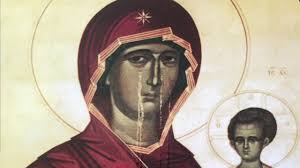
The Bible naturally says nothing about the Theotokos in centuries whiich followed: Her miraculous protection and love shown to people, her numerous weeping icons. (See Post 79), her occasional appearances. And a lot more.
All these came with time.
For one small example, the time when a rather “fussy” bishop was visiting our Saint Nicholas Church. Deacon John and I were both extremely nervous, but as we stood before the icon of the Theotokos on our icon screen saying our preparatory prayers, we each independently felt a coolness, a calm, a peace pour forth almost palpably from her, and after that we were at ease. After Liturgy we were amazed to find that we had both had the same experience.
Let me stress this: Of course, we honor and obey God first, Father, Son and Holy Spirit. He is the source of all things. None of the saints, beginning with Mary, would think of doing anything contrary to the will of God. That’s why they are saints. Their work on earth is this only: to lead us to their Lord and God and Savior Jesus Christ, and ours.
But let’s have none of this “me and Jesus” religion, or even “me and God”. If you become a Child of God, you get the whole Family, in Heaven and on earth. Including Mother.
So if any of you have read the Bible and have missed Blessed Mary, please read again. It is sad beyond words that so many Christians today are “without” their Mother Mary and her love. But actually they’re not. Like all good mothers, she never stops loving her children – even those who have forgotten her.
Mary the Mother of God, Mary our Mother, Mary full of grace.

+ + + + + + +
Next Week: I’ve got to go traveling again!
Week after Next: This depends on whether I’m back from my trip yet.